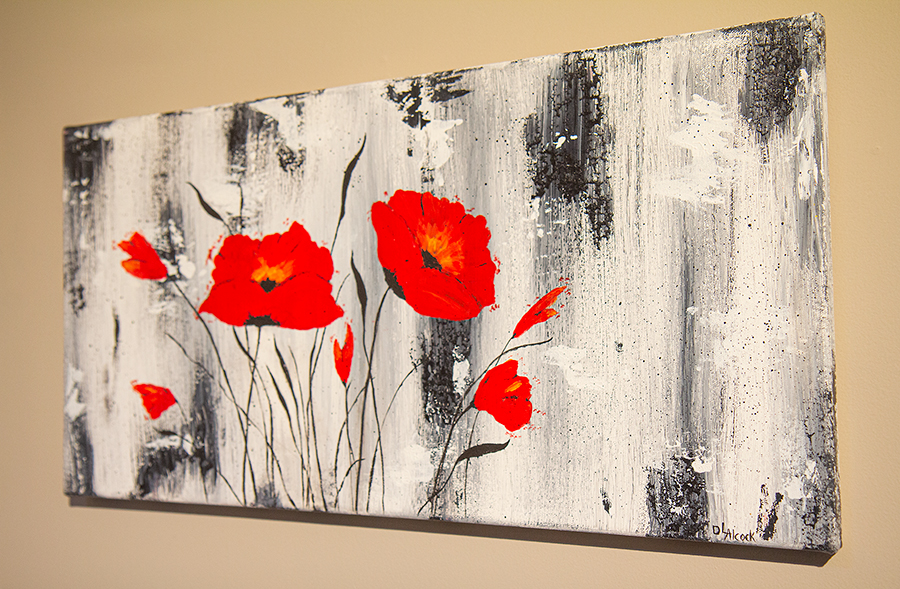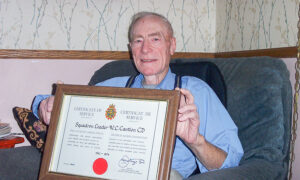
‘Five brothers left for war, and five returned.’
This story, written by late reporter Betty Storie, originally ran in the November 7, 2003 edition of The Guide.
BY BETTY STORIE
When Lynn Cantlon joined the Air Force in November, 1942, he was not yet 18 years old.
Three older brothers had already enlisted in the army, and this younger brother was eager for the moment when he would join them.
Everette, Art, Darrel, Lynn, and Alvin were raised on a farm southeast of Cartwright. None were married when they set off to war in distant lands. Perhaps that made it easier for them.
But it could not have been easy for their parents, Theade and Flossie Cantlon, and two sisters, Dorothy and Aimee, who were left to await their return.
Lynn joined the Air Force as a rear gunner. He began training in Souris, Manitoba, before being sent to Quebec for ground school and flight training. By September 1943, he was stationed in Gayton, England, with his operational training unit.
“We began on twin-engine Wellingtons before moving to the four-engine Halifax. We were on our last training trip – a decoy raid – when we lost an engine and crash-landed,” Lynn explains.
As rear gunner, he took the brunt of the impact, suffering a broken back and leg. The other crewmembers were not injured. Lynn spent three months recovering in hospital in Harrogate, England, before he was deemed fit to fly. He joined Squadron 432 as spare gunner, to fly with whatever crew required his services.
It was May 8, 1944, when Lynn went out on his first mission. The target was a large railway yard in Haine St. Pierre, France. The night raid took place under a full moon, making the bombers easy targets for the German anti-aircraft guns.
Their mission completed, the crew headed back toward England, only to be shot down near the coast of France. Three of the crew were killed. Four bailed out, and were taken prisoner by the Germans.
Lynn and his companions were taken to Frankfurt for interrogation and solitary confinement. They were then shipped to Stalag Luft III, 100 miles southeast of Berlin. “That was the setting of the movie, The Great Escape,” Lynn notes. The tragically unsuccessful escape had taken place on March 24, only a couple of months before Lynn’s arrival.
Nine months later, in the winter of 1945, with the Russians advancing from Poland, the S.S. marched their prisoners-of-war across Germany to Bremerhaven, on the North Sea.
By April, the Allied Forces were advancing from the west, and the prisoners were on the move again, this time trudging north to Denmark.
“The Germans were demoralized, and they didn’t have enough guards on the march,” Lynn explains. He and another prisoner took advantage of the opportunity to escape. They were free for 10 days, before their recapture on the front lines. They spent four days in the Bergen-Belsen concentration camp. It was April, 1945, and Bergen-Belsen held over 60,000 civilian and military prisoners. Anne Frank had been among them, dying of typhus just weeks before the camp was liberated by the Americans on April 14.
Lynn was not there to witness the liberation. He was on yet another forced march when he and a fellow prisoner overpowered the guards and escaped into the countryside.
“By this time, the Allies were over the Rhine. The Scots Guards picked us up in May 1945 and shipped us to Brussels,” Lynn concludes, adding, “We were in England in time to celebrate VE Day (Victory in Europe-May 8, 1945).”
Lynn remained in England until he was flown home to Winnipeg in July, 1945.
Lynn’s younger brother did not see combat. He was on his way to Japan when VJ Day was declared on August 15, 1945.
Darrel and Ev returned from the European campaign in August 1945.
Five brothers left for war, and five returned. And a reunited family celebrated their exceptional good fortune.
Despite having been returned to active duty following the training accident in the spring of ‘44, Lynn was required to spend seven months in the Deer Lodge Hospital for further treatment for his back and leg injuries. “I guess I was deemed fit to fight, but not to discharge,” he laughs. Lynn married, and he and his wife Janet had four children – three boys and a girl. One son, Bill, lives in Cartwright. In 1952, Lynn rejoined the Air Force, and served as radar ground crew. He was Squadron Leader and Base Operations Officer in Winnipeg when he retired after 27 years total service.
From 1976 to 1989 Lynn worked as a civilian with the American Air Force on the DEW line. “I worked six months in and eight weeks out while Janet lived in Winnipeg. The kids were grown by then,” he said.
The Cantlons then bought a small acreage two miles north of Killarney where Lynn still resides.
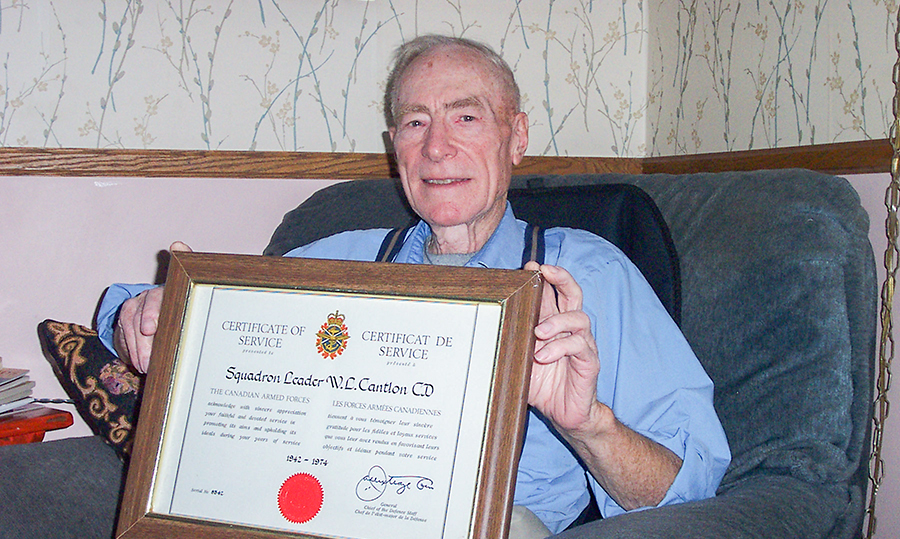
CERTIFICATE OF SERVICE – Lynn Cantlon wasn’t even 18 years old when he enlisted with the Air Force in November of 1942 to serve in WWII. Cantlon’s story, above, appears as it did in the November 7, 2003 edition of The Guide.
BETTY STORIE/KILLARNEY GUIDE PHOTO
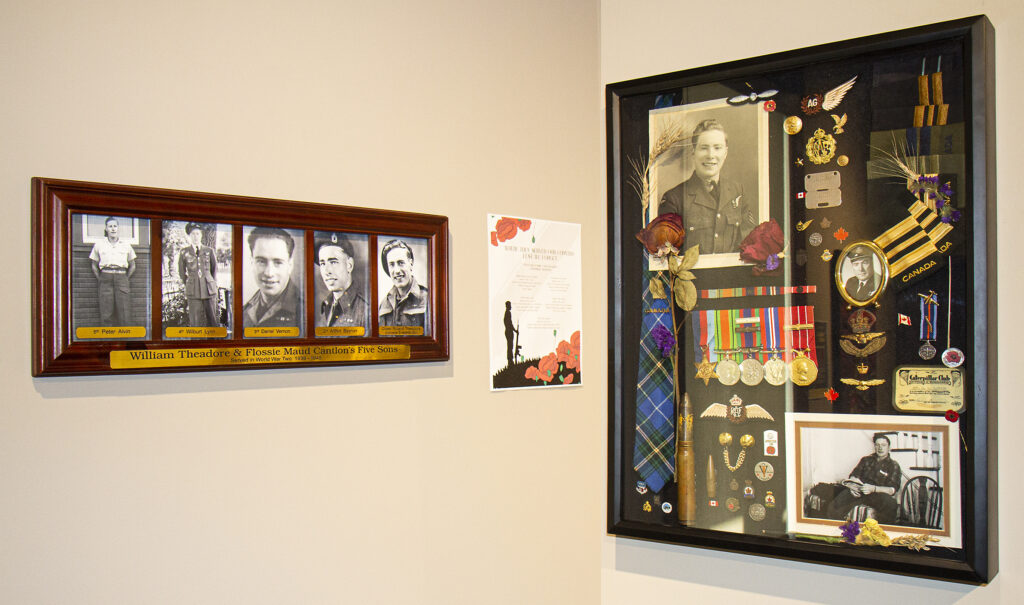
TRIBUTE TO LYNN CANTLON – Above, right: a family’s framed memorial to the life and WWII career of Lynn Cantlon, including his numerous medals, epaulets, wings, photos, pins, a tie, and more.
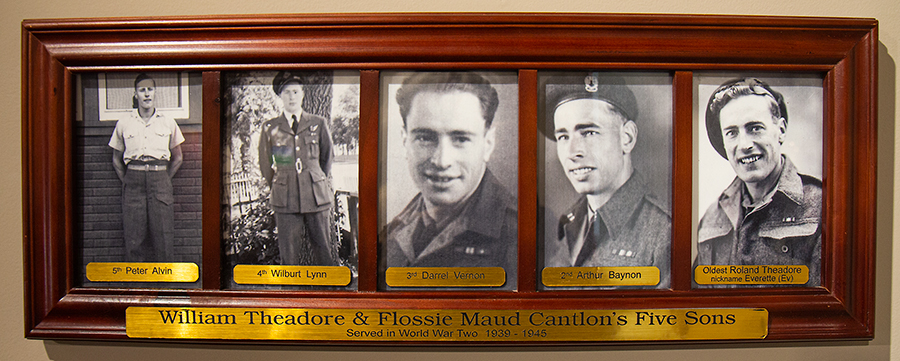
THE CANTLON BROTHERS: FIVE WENT TO WAR, AND FIVE RETURNED – Part of this month’s Remembrance-themed art exhibition at the Heritage Home for the Arts includes an homage to the five Cantlon brothers: Roland Theodore (nickname ‘Everette’); Arthur Baynon; Daniel Vernon; Wilburt Lynn; and Peter Alvin. They were the sons of William and Flossie Cantlon, and all five served in World War II. And all, remarkably, returned home. Photos, a collection catalogue of letters and artwork from children, a framed display of medals, memorabilia, and more, are all on poignant display until November 26.

TRIBUTE ALBUM – left: a long-ago page in the Cantlon’s hefty tribute album, complete with letters and pictures done by schoolchildren over the decades, and a family treasure.
ART ON DISPLAY – Following are a few of the many pieces of art on display at the Heritage Home for the Arts until November 26…
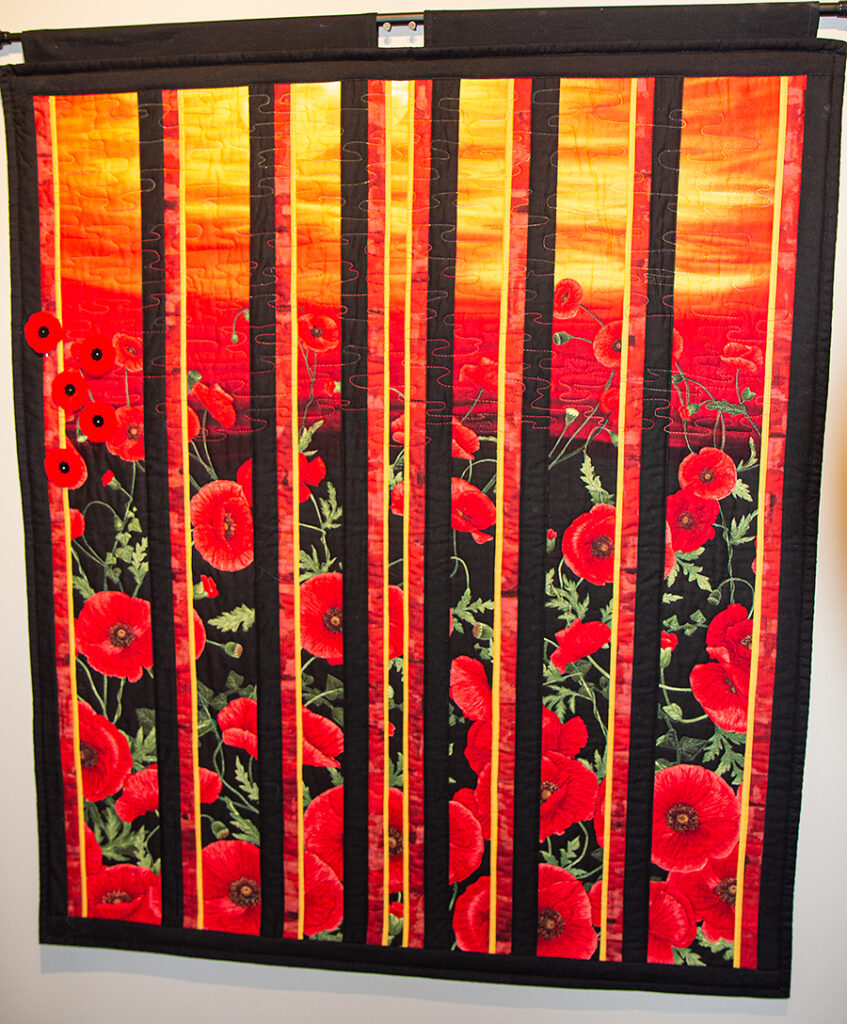
GLORIOUS POPPIES TO REMEMBER – Adelyn Nichol’s gorgeous, sunset poppy quilt adorns one of the walls of the Heritage Home for the Arts during this celebrated month of remembrance.
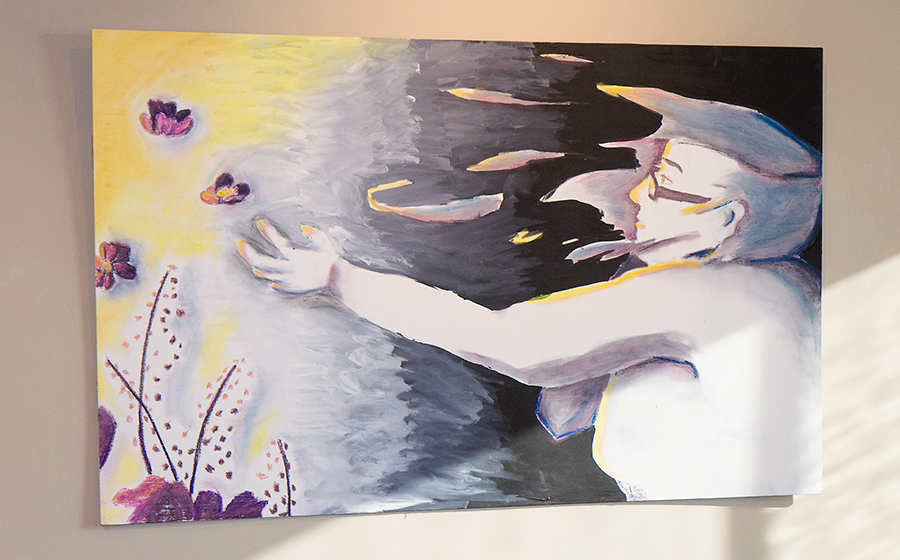
REMEMBERING LOSS – Brandon artist TJ Southam submitted this beautiful painting, ‘Loss,’ which depicts her image of a woman casting purple flowers into the wind and light. The current exhibition, which runs this month at the Heritage Home for the Arts, explores the concept of remembrance, in its many forms, as a theme.
